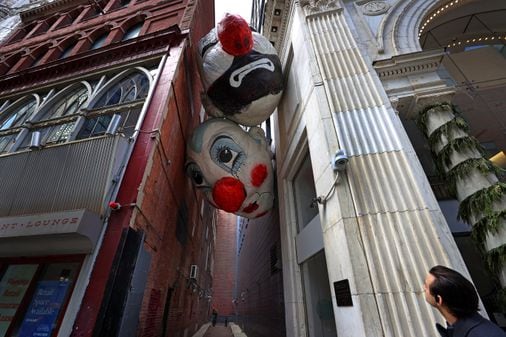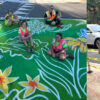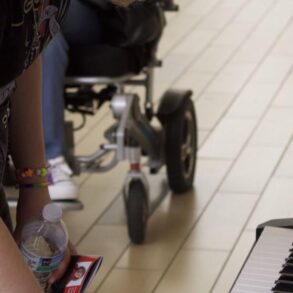
I don’t know where you were for this past weekend’s polar vortex, but I spent a good chunk of my Saturday afternoon navigating the subzero wind tunnels blasting much of downtown in search of the dozen-plus public art installations littered through the district by its business improvement association. Collectively known as WINTERACTIVE — in all caps, of course — the goal is to lure people on a walking tour of its chilly streets. Huddled in a doorway on High Street before braving the next gust, I had some thoughts.
First: Now? Really? Though WINTERACTIVE makes its case; the whole affair, trucked in from Quebec (the Quebec tourism board is listed as a partner on the project), means to share our northern neighbors’ embrace of the season: “We hope WINTERACTIVE gives Bostonians and our visitors a reason to enjoy the winter season like the Quebecers!” the sunny text on its website goes.
Full disclosure: I’m Canadian (WINTERACTIVE’s subtitle, “A Canadian Art Experience in Downtown Boston,” induced a cringe), and believe me, we don’t love winter any more than you do; the calluses are just thicker. But whatever the season, public art is a delicate realm that should be practiced with at least a little sensitivity, especially when you’re asking people to brave frostbite to experience it.
Public art, it needs be said, is a hater’s game: Put big art installations out where people literally can’t avoid them, and watch the “everyone’s a critic” adage lurch to life. That’s not to say there’s no right way to do it; just that there are countless wrong ways. And, friends, Boston’s WINTERACTIVE is one of those.
For me, public art starts and ends with a sense of place: What it can reveal or provoke about the spaces it occupies, in the very specific context of the city itself. WINTERACTIVE — it hurts to even type — is not that, and means nothing to Boston at all. Each of the works feels unracked from a vast public art warehouse and plopped in any available space, probably because that’s exactly what they are.
You may have already seen too much of Max Streicher’s “Endgame (Nagg & Nell),” the pair of inflatable clown heads, online. In real life right now, they’re stuck in an alleyway alongside Suffolk’s Modern Theatre I’ve seen previous versions of them in person before, most notably during Toronto’s annual overnight art extravaganza, Nuit Blanche (it lasts just 12 hours). They mean as much here as they did there, and if you’re grasping for what meaning to draw from two giant inflatable clown heads stuck between buildings, allow me to enlighten you: They are two giant inflatable clown heads stuck between buildings. Beyond the surprise — the best thing about them — there’s truly no there there.
Not to pick on Streicher, whose inflatable sculpture has been a staple of outdoor public art spectacles for years. Most of the other pieces I managed to find were just as disconnected, if not so monumentally. “Island of Warmth,” by the Quebec design studio ATOMIC3, at least threw a little heat my way on a frosty corner of Summer Street (oh, the irony), though nowhere near enough; a stand of light bulbs on long stems, it’s a glowy island with nothing to offer but a little light on a dark and miserable corner. There’s also a hand-cranked music box festooned with snowflakes (wear gloves, please), a few stationary bikes that light up when pedaled, and, in a grating emblem of our self-obsessed times, a tacky picture frame to facilitate the inevitable Instagram post.
To be generous, some of WINTERACTIVE’s works fumble for something like meaning: Mathias Gmachl’s “Echoes — A Voice From Uncharted Waters” combines a long steel-ribbed effigy of a blue whale with an eerie sound installation that shifts from mournful whalesong to dire industrial grinding if people come too close, a painfully on-the-nose gesture toward our dire environmental dilemma. But it’s part of a grab-bag that makes clear that no guiding ethos for the project exists.
Four pieces by Mark Jenkins are the best things on offer, in the sense that they do what I think WINTERACTIVE might be inadvertently groping toward: A subset of art called public intervention, where subtle insertions in the urban landscape refashion the familiar as strange, and prompt you, the viewer, to see taken-for-granted spaces in a new way.
Jenkins’s work is indeed subtle, but also jarring: hyper-realistic figures, like a woman suspended on a swing over Winter Street, or an upside-down stair-climber on a fire escape on Bromfield. As something of a proof point, one of the pieces, a man with legs dangling over the street in Downtown Crossing, was removed after at least one concerned person called the police. (The piece is due to be reinstalled on the roof of the Macy’s building later this week).
But works like Jenkins’s, and Streicher’s — which despite it all, I count as the best things here — peter out after the initial shock. They’re disruptively weird one-liners, not an inherently bad thing; but weird shifts to dull pretty quickly, which is why, as a discipline, public intervention is necessarily ephemeral. Nuit Blanche, in Toronto, lasts only from sundown to sun-up, once a year — in the forgiving climate of early fall, please note — and for good reason; any longer would leave most of the work as stale as day-old Dunkin’. WINTERACTIVE, though, is hunkered down until April — April! — neutering whatever potential for surprise it might have, and letting the poor thinking behind it linger.
I know, I know — I’m a wet blanket, and can’t this just be fun? Sure, it could be. But we can ask more of anyone demanding our time and attention in the shared spaces we can’t avoid than a context-free traveling roadshow unboxed and dusted off for wherever the dollars take it.
And I get it. Art — real art, with purpose and meaning — can be hard. No-one wants to stroll around Downtown Crossing on an enormous downer, especially since the neighborhood is on a downer all on its own these days, which might be the reason behind all this. I don’t take issue with the public sphere being a space for levity and hope, and I can only applaud the good intentions of taking action to buoy a flailing neighborhood anchored right in the city’s heart. But WINTERACTIVE feels like a quick-fix driven by desperation, when a better option seems there for the taking.
Last I checked, Boston has its very own vibrant public art agency, Now + There, that’s been cultivating a thriving scene of artists right in this very city for public projects for years. Now + There is in the thick of launching a public art triennial, starting next May, which will distribute short-term public art installations all over the city in a mindfully curated example of what public art, at its best, can do to reflect and engage the place where it lives.
A meaningful collaboration might have served both interests: For the association, real engagement with the challenges of its community, through artists who actually know and care; and for Now + There, a dry run for the civically minded cultural enterprise it has in mind — one that speaks to the very city that it calls home. If only. Merci, Quebec. But, non.
Murray Whyte can be reached at murray.whyte@globe.com. Follow him @TheMurrayWhyte.
This post was originally published on this site be sure to check out more of their content







